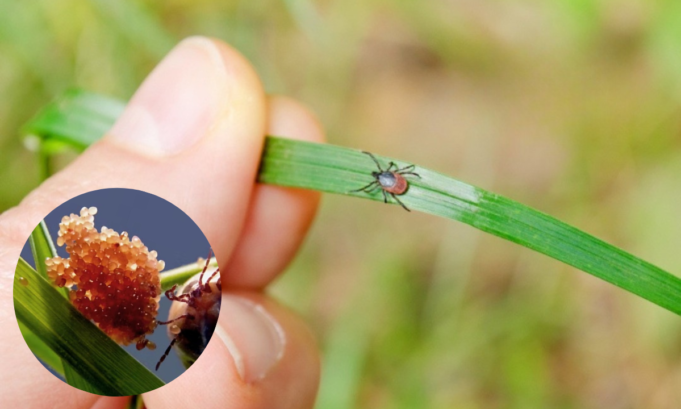If You See These Eggs in Your Yard, Act Fast – How to Identify and Get Rid of Tick Eggs!
Did you know that those tiny clusters of eggs in your yard could hatch into dangerous ticks, spreading diseases like Lyme disease and Rocky Mountain Spotted Fever? Understanding how to identify, remove, and prevent tick eggs from hatching is essential for keeping your family and pets safe. Let’s dive into the telltale signs of tick eggs, the risks they pose, and the best ways to eliminate them before they become a bigger problem!
🥚 How to Identify Tick Eggs
Tick eggs are small—about the size of a poppy seed (0.5 mm)—and often go unnoticed until they hatch into disease-carrying larvae. Here’s what to look for:
✔️ Shape: Oval or pear-shaped
✔️ Color: Translucent, pale yellow, light brown, or whitish
✔️ Texture: Smooth and shiny
✔️ Location: Found in hidden, moist spots like:
Leaf litter
Tall grass
Under garden debris
Around woodpiles or stone walls
Different tick species may have slightly different egg colors, but they all tend to hide in shaded and humid areas where they can easily hatch and thrive.
⚠️ Why Tick Eggs Are a Serious Threat
Once tick eggs hatch, they release larvae that can latch onto humans and animals, transmitting dangerous diseases such as:
🔴 Lyme disease – Caused by Borrelia burgdorferi bacteria
🔴 Rocky Mountain Spotted Fever – A potentially fatal bacterial infection
🔴 Ehrlichiosis – A bacterial infection that attacks white blood cells
🔴 Babesiosis – A parasitic infection that can cause flu-like symptoms
Even a small cluster of tick eggs can result in a full-blown infestation, increasing the risk of exposure to these harmful diseases.
🛡️ How to Remove and Dispose of Tick Eggs
When you spot tick eggs, handling them correctly is key to preventing an outbreak. Here’s how to remove them safely:
🧤 1. Protect Yourself: Always wear gloves to avoid direct contact with the eggs.
🪣 2. Collect and Seal: Carefully scoop the eggs into a sealed plastic bag or container.
🍶 3. Kill the Eggs:
Submerge the eggs in alcohol or hot soapy water.
Seal the bag tightly and dispose of it in an outdoor trash bin.
🚽 4. Flush Them: You can also flush the eggs down the toilet to prevent hatching.
❌ 5. DO NOT CRUSH: Crushing tick eggs can release bacteria or harmful pathogens.
🌿 Natural Ways to Control Tick Populations in Your Yard
You don’t need to rely on harsh chemicals to keep ticks at bay. Here are some effective natural solutions:
🌲 1. Essential Oils
Certain essential oils are natural tick repellents:
✅ Cedarwood
✅ Neem
✅ Eucalyptus
✅ Citronella
✅ Peppermint
✅ Rosemary
✅ Clove
👉 Mix a few drops with water and spray the mixture around your yard, focusing on shaded or grassy areas.
🏞️ 2. Diatomaceous Earth (DE)
DE is a natural powder that kills ticks by dehydrating them.
👉 Sprinkle food-grade DE around woodpiles, tall grass, and leaf piles.
👉 Reapply after rain for maximum effectiveness.
🌸 3. Plant Tick-Repelling Plants
Certain plants naturally deter ticks:
✅ Mint
✅ Rosemary
✅ Garlic
✅ Chrysanthemums
✅ Lavender
👉 Plant them along the perimeter of your yard or near entry points to keep ticks away.
🚶 4. Create a Tick Barrier
Ticks avoid crossing dry, open spaces.
👉 Create a gravel or mulch barrier around your yard to keep them from migrating toward your home.
🐭 5. Use Tick Tubes
Tick tubes are filled with treated cotton that mice use for nesting. The treatment kills ticks without harming the mice.
👉 Place tick tubes around the edges of your yard or in shaded areas.
✂️ Preventative Measures to Keep Ticks Away
✅ Keep Grass Short: Mow regularly to eliminate tick-friendly hiding spots.
✅ Clear Debris: Remove leaf litter and woodpiles to reduce tick nesting areas.
✅ Reduce Moisture: Fix drainage issues and avoid overwatering.
✅ Eliminate Rodent Hiding Spots: Ticks often hitch a ride on small mammals like mice.
✅ Install Hardscaping: Paths, patios, and gravel reduce grassy areas where ticks thrive.
🏡 Safe Use of Insecticides (If Necessary)
If the tick problem persists, you may need to use insecticides:
💧 Cedar oil – A natural insecticide that’s safe for pets and humans.
💥 Synthetic pyrethroids – Effective but should be applied carefully according to the manufacturer’s instructions.
👉 Always use pesticides sparingly and keep pets and children away from treated areas until dry.
👀 Stay Vigilant and Stay Safe
Managing ticks is an ongoing process—but staying proactive can prevent a serious infestation. Here’s how to stay on top of it:
✔️ Regularly inspect your yard for tick eggs and larvae.
✔️ Use essential oils, DE, and natural repellents consistently.
✔️ Keep your yard tidy and free of overgrown grass and debris.
✔️ Seek professional help if you notice a significant tick population.
🚀 Take Action Before It’s Too Late!
A single batch of tick eggs can lead to a dangerous infestation—don’t wait until it’s too late. By identifying and removing tick eggs early and following these preventive measures, you can protect your home, your pets, and your family from the dangers of ticks.
👉 Spot tick eggs in your yard? Act now—your family’s health depends on it!









